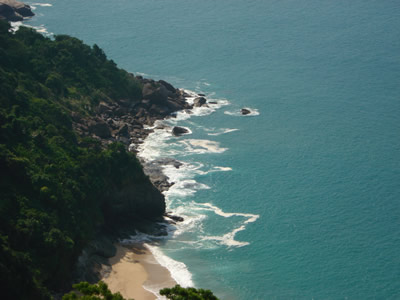How Will Climate Change Impact the Coast of
Latin America and the Caribbean?

Photo: Dario Sanches, Flickr
This is what the Regional study into the effects of climate change on the coast of Latin America and the Caribbean is attempting to find out, as part of a project being carried out by the ECLAC Sustainable Development and Human Settlements Division, The Spanish Office for Climate Change (which comes under the Ministry of Agriculture, Food and the Environment) and the Environmental Hydraulics Institute of the University of Cantabria.
The three institutions developed a specific methodology for assessing the impact of climate change in coastal areas, and this has been made available to Latin American and Caribbean countries.
The coastal area studied is 72,182 km long and covers four geographical areas: North America, Central America, South America and the Caribbean islands.
This research could be highly useful, for instance in coast and port engineering, risk assessment of human settlements in coastal areas and the integrated management of coastal environments and ecosystems.
The research will also enable estimates to be made of local impact and will make it possible to suggest adaptation measures to the phenomenon known as "El Niño Southern Oscillation" (ENSO), extreme hydro-meteorological events and climate change, as well as providing an opportunity for an economic analysis of the measures considered.
The regional study includes a total of six publications: four main documents and two supplementary ones (only in Spanish), as well as a web viewer with the results ordered by variable.
The first document presents an atlas of the current physical conditions and changes detected in coastal variables, including average sea level and surface temperature, salinity, waves, astronomical tide and anomalies in the temperature of the air, wind and hurricanes, before examining trends and climate variability in the area studied.
The second main document, which is about the vulnerability and exposure of coasts, analyses the physical, socio-economic and ecological characteristics of these areas in Latin America and the Caribbean, in order to determine their vulnerability to the impact of global warming. The effects of climate change on coasts must be assessed in accordance with the various elements that make up the ecosystems, such as beaches, estuaries, dune systems and maritime structures.
The third publication, which focuses on the expected impacts, examines the probability of coastal flooding as a result of rising sea levels and extreme events, beach erosion due to changes in waves and sea level, new conditions facing ports in the region and the level of security of their protective structures.
The fourth document analyses the main risks associated with climate change, for the population and for ecosystems on the coast. Beach erosion was also considered, as beaches protect coastal cities and are a recreational resource in the area.
The first additional document was devised as a theoretical guide to coastal engineering, as it provides a review of concepts commonly used in this sphere.
Also as part of the Regional study into the effects of climate change on the coast of Latin America and the Caribbean, a methodological guide was produced to describe the integral risk assessment method developed for the project. Methodologies for risk assessment in the literature were revised and redefined for this purpose.
Lastly, a
web viewer
was created to present the results by various variables such as
coastal dynamics, trends, vulnerability and impact.
| The regional study includes a total of six publications: four main documents and two supplementary ones, as well as a web viewer with the results ordered by variable. | |
|
|
|
|
The effects of climate change on coasts must be assessed in accordance with the various elements that make up the ecosystems, such as beaches, estuaries, dune systems and maritime structures. |
|